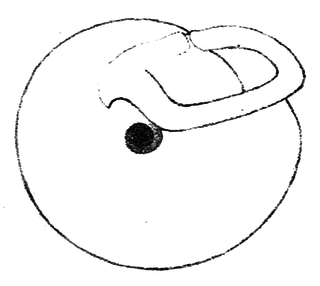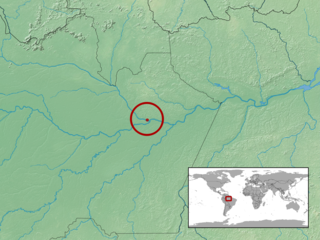
Fernando de Noronha, officially the State District of Fernando de Noronha and formerly known as the Territory of Fernando de Noronha until 1988, is an archipelago in the Atlantic Ocean, part of the State of Pernambuco, Brazil, and located 354 km off the Brazilian coast. It consists of 21 islands and islets, extending over an area of 26 km2 (10 sq mi). Only the eponymous main island is inhabited; it has an area of 18.4 km2 (7.1 sq mi) and a population estimated at 3,101 in 2020. While most of the archipelago is relatively low-lying, there are parts reaching more than 100 m (328 ft) in elevation.

Amphisbaenia is a group of typically legless lizards, comprising over 200 extant species. Amphisbaenians are characterized by their long bodies, the reduction or loss of the limbs, and rudimentary eyes. As many species have a pink body and scales arranged in rings, they have a superficial resemblance to earthworms. While the genus Bipes retains forelimbs, all other genera are limbless. Phylogenetic studies suggest that they are nested within Lacertoidea, closely related to the lizard family Lacertidae. Amphisbaenians are widely distributed, occurring in North America, Europe, Africa, South America, Western Asia and the Caribbean. Most species are less than 6 inches (15 cm) long.

The Amphisbaenidae are a family of amphisbaenians, a group of limbless vertebrates.

Noronhomys vespuccii, also known as Vespucci's rodent, is an extinct rat species from the islands of Fernando de Noronha off northeastern Brazil. Italian explorer Amerigo Vespucci may have seen it on a visit to Fernando de Noronha in 1503, but it subsequently became extinct, perhaps because of the exotic rats and mice introduced by the first explorers of the island. Numerous but fragmentary fossil remains of the animal, of uncertain but probably Holocene age, were discovered in 1973 and described in 1999.

The Noronha skink is a species of skink from the island of Fernando de Noronha off northeastern Brazil. It is covered with dark and light spots on the upperparts and is usually about 7 to 10 cm in length. The tail is long and muscular, but breaks off easily. Very common throughout Fernando de Noronha, it is an opportunistic feeder, eating both insects and plant material, including nectar from the Erythrina velutina tree, as well as other material ranging from cookie crumbs to eggs of its own species. Introduced predators such as feral cats prey on it and several parasitic worms infect it.

Amphisbaena is a genus in the family Amphisbaenidae, commonly known as worm lizards. Over 100 species are placed in this diverse genus.

Amphisbaena alba, also known as the red worm lizard or less commonly as the white or white-bellied worm lizard, is a species of amphisbaenian in the reptilian order Squamata. Despite the large geographic range that this species covers, little is known about its ecology due to its secretive habits. A. alba has a diverse diet ranging from plant material to small vertebrates. Numerically, beetles, ants, and spiders compose the majority of their diet; however, ants, insect larvae, beetles, cockroaches, hemipterans, mole crickets, crickets, grasshoppers, termites, spiders, scorpions, pseudoscorpions, and annelids are ingested to satisfy a larger volume. The females are somewhat larger than the males, and can reach over 80 cm, which is quite large for an amphisbaenian. They are known to bury themselves in leafcutter ant nests and hide in the ants’ garbage dump areas to avoid irritating the ants into attacking, and to bury themselves to avoid predation in general.

Darwin's ringed worm lizard is a species of amphisbaenian in the family Amphisbaenidae, endemic to South America.
Heath's worm lizard is a species of amphisbaenian in the family Amphisbaenidae. The species is endemic to Brazil, in the state of Rio Grande do Norte.
Vanzolini's worm lizard is a species of amphisbaenian in the family Amphisbaenidae. The species is native to northern South America.

Hyperaulax ridleyi is a species of tropical air-breathing land snail, a terrestrial pulmonate gastropod mollusk in the family Odontostomidae.

Amphisbaena mertensii, also known as the Mertens' worm lizard or Mertens's worm lizard, is a species of worm lizard in the family Amphisbaenidae. The species is endemic to South America.

Leposternon microcephalum, also known commonly as the smallhead worm lizard, is a species of amphisbaenian in the family Amphisbaenidae in the reptilian order Squamata. The species is endemic to South America.
The Cuban many-ringed amphisbaena, also known commonly as the Cuban many-ringed worm lizard, is a species of amphisbaenian in the family Amphisbaenidae. The species is endemic to Cuba.
Amphisbaena cegei is a species of amphisbaenian in the family Amphisbaenidae. The species is endemic to Bolivia.
Amphisbaena medemi is a species of worm lizard in the family Amphisbaenidae. The species is endemic to Colombia.

Slevin's worm lizard is a species of amphisbaenian in the family Amphisbaenidae. The species is endemic to northern South America.
Spurrell's worm lizard is a species of amphisbaenian in the family Amphisbaenidae. The species is endemic to Central America and northern South America.
Amphisbaena steindachneri is a species of worm lizard in the family Amphisbaenidae. The species is endemic to South America.












